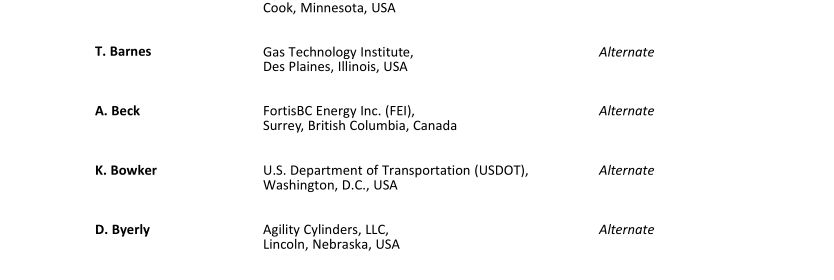CSA NGV 6.1-2016 pdf download – Compressed Natural Gas (CNG) fuel storage and delivery systems for road vehicles.
1 Scope 1.1 This Recommended Practice applies to the design, installation, inspection, repair, and maintenance of a fuel storage and delivery system installed in an on road vehicle for use with compressed natural gas (CNG). This includes a fuel system on a self-propelled vehicle for the provision of motive power. Note: This Recommended Practice is intended to cover the fuel storage and delivery system as defined in Figure 1. Elements downstream of the regulation device(s) or stage(s) such as the low pressure delivery line and injectors are not included in the Scope of this Recommended Practice. 1.2 This Recommended Practice does not apply to: a) stationary engines; b) mobile equipment using natural gas as a fuel for other than propulsion; or c) electronic control module or controls strategy of a fuel management system. Future editions of this Recommended Practice may include: a) liquefied natural gas (LNG) fuel storage system; b) compressed natural gas (CNG) portion of an LNG vehicle; c) storage or utilization of natural gas on boats or trains; d) powered industrial trucks; e) off road applications including mining applications, all-terrain vehicles; and f) motorcycles. 1.3 OEM compressed natural gas vehicles and containers that have been qualified under the Canadian Motor Vehicle Safety Regulations or U.S. Federal Motor Vehicle Safety Standards (FMVSS) are exempt from the requirements in this Recommended Practice. 1.4 All references to pressure throughout this Recommended Practice are to be considered gauge pressures, unless otherwise specified.
1.6 In this Recommended Practice, “shall” is used to express a requirement, i.e., a provision that the user is obliged to satisfy in order to comply with existing codes; “should” is used to express a recommendation or that which is advised but not required; and “may” is used to express an option or that which is permissible within the limits of the Recommended Practice. Notes accompanying clauses do not include requirements or alternative requirements; the purpose of a note accompanying a clause is to separate from the text explanatory or informative material. Notes to tables and figures are considered part of the table or figure and may be written as requirements. Annexes are designated normative (mandatory) or informative (non-mandatory) to define their application. 2 Reference publications This Recommended Practice refers to the following publications and unless otherwise noted, the publication of a document is the most recent edition, or to the edition in effect at the time that the vehicle was designed or the conversion completed. CSA Group ANSI NGV 2 Compressed natural gas vehicle fuel containers ANSI NGV 3.1/CSA 12.3 Fuel system components for compressed natural gas powered vehicles ANSI NGV 1/CSA NGV 1 Compressed natural gas vehicle (NGV) fueling connection devices ANSI PRD 1 Pressure relief devices for natural gas vehicle (NGV) fuel containers CSA B109 (Part 1) Natural gas for vehicles installation code EXP2.1-16 Best practice for defueling, decommissioning, and disposal of compressed natural gas vehicle fuel containers
ASTM International IEEE/ASTM SI 10 American National Standard for Metric Practice Automotive Industry Action Group Potential Failure Mode and Effects Analysis, FMEA, 4 th Edition AIAG Government of Canada Motor Vehicle Safety Regulations, C.R.C., c. 1038 INCOSE (International Council on System Engineering) INCOSE Systems Engineering Handbook: A Guide for System Life Cycle Processes and Activities ISO (International Organization for Standardization) 9001:2008 Quality Management Systems — Requirements by an accredited registrar TS 16949:2009 Quality management systems — particular requirements for the application of ISO 9001:2008 for automotive production and relevant service parts organizations 1179-1 Connections for general use and fluid power — Ports and stud ends with ISO 228-1 threads with elastomeric or metal-to-metal sealing — Part 1: Threaded ports 1179-2 Connections for general use and fluid power — Ports and stud ends with ISO 228-1 threads with elastomeric or metal-to-metal sealing — Part 2: Heavy-duty (S series) and light-duty (L series) stud ends with elastomeric sealing (type E) 1179-3 Connections for general use and fluid power — Ports and stud ends with ISO 228-1 threads with elastomeric or metal-to-metal sealing — Part 3: Light-duty (L series) stud ends with sealing by O-ring with retaining ring (types G and H)CSA NGV 6.1-2016 pdf download.
